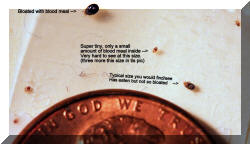|
Snake mites - ugh!
Do you have them?
How did you get them?
How
do you get rid of them!
Do you have them?
Snake mites are a external parasite that feeds on the blood of
snakes. The mites themselves are translucent and almost
invisible until they have fed and have a blood meal in their
stomach. Able to stretch and expand several times their
original size to accommodate a large meal. This is a pic
with several mites in it including some with larger blood meals and
some with minimal blood meals.

Often times you discover there are mites by seeing your snake
hanging out in it's water bowl more than normal or even
seeing the drowned mites in the water - looks like pepper flakes on
the bottom. If you are observant, sometimes you can even see
the mites crawling on the snake, most often towards the head
although they can be anywhere. Snake mites are only on a snake
to feed. They leave to lay their eggs away from the host often
on wood or paper.
How did you get them?
Snake mites most often come in on newly acquired snakes.
From a pet store, clearing house or even sometimes from a breeder.
Snakes are like magnets for mites so anytime they pass through a
facility that has mites they run the risk of one or more "hopping on
board" for a free ride with meal. All newly acquired snakes
should be quarantined at a minimum and have the enclosures properly
treated for mites to prevent any hitchhikers from leaving the snake
and laying eggs. By treating the enclosure you could eradicate
the lone mite on the snake and never have the infestation that could
occur. Any wood or paper product coming from a pet
store could be harboring mites and/or eggs so should be handled with
care and measures taken to prevent any living mites from
propagating.
How do you get rid of them?
Step 1) Direct animal treatment - IMO should only be done for
those animals visibly infested. There are products available
(Reptile Relief and others) that can be applied directly to the
infested animal. These products, while effective at killing
mites themselves, are not effective at preventing re-infestation by
eggs hatching from escaped mites. ie your snake may be mite
free right after treatment but re-infested shortly thereafter.
The real key in stopping any infestation is to not allow mites to
get back to the snake to feed.
Step 2) Enclosure and surrounding area treatment - For this I
use Provent-a-Mite (PaM). PaM is extremely effective at
killing any mites on surfaces. NOT TO BE USED DIRECTLY ON
SNAKE! Follow the directions carefully as this is a poison and
if used in proper amounts it's not harmful to you or your snake.
Not one of those if a little is good, more is better products.
Basically you need to strip the enclosure of any bedding and use
paper towels for bedding until the infestation is over. The
added benefit of paper towels is being able to see the dead mites if
there are any. If you still see "new" dead mites on the paper
towel(s), the war is not yet over. You spray the proper amount
of PaM on bedding (paper towels) and surrounding areas and any mite
that crawls across a treated surface dies. If they can't get
to dinner without crossing a kill zone they can't eat and reproduce.
After a month of no new eggs being laid there are no more mites
left!
Let me re-emphasize, you need to continue to treat the bedding
(paper towels) each time you change them out for ONE MONTH after you
spot the last dead mite to be certain all the mites are dead and no
more eggs are waiting to hatch.
One other point with PaM, the mites don't die instantly on contact
with a treated surface. They do however die before they can
feed, leave the snake and reproduce.
Step 3) Other stuff - any time you bring in new bedding or new wood
furnishings, branches, log hides etc. They could have a
hitchhiker on them. Always best to give the new wood item a
quick spray with PaM and let sit away from your reptiles for a
few days just to be safe. Bedding can be frozen or baked to
kill off any unwanted pests.
Hope this helps and remember, it's much easier to prevent the
infestation then to cure it.
Dave Colling,
Rainbows-r-us-reptiles.com
|